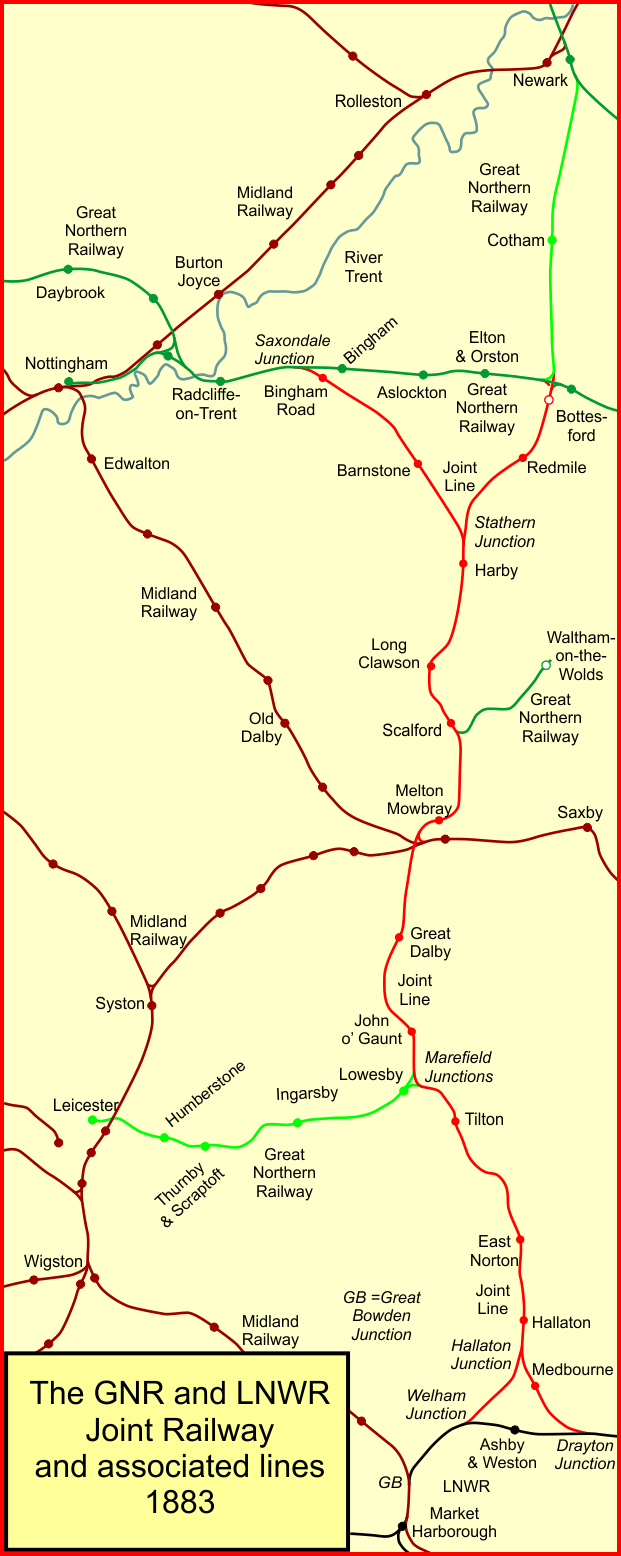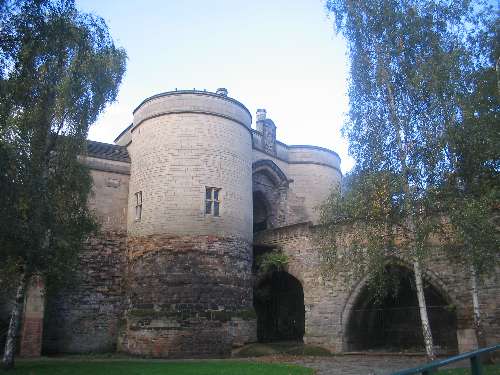|
Barnstone
Barnstone is an English village in the Rushcliffe borough of Nottinghamshire, forming part of Langar cum Barnstone parish. It lies on the border with Leicestershire. The nearest retail stores, schools and railway station are in Bingham (4.5 miles, 7 km). The spelling in the 19th century was usually "Barnston". The parish church of St Mary's belongs to the Wiverton group, but is not currently in use. Heritage The Domesday Book of 1086 states that Barnstone contained 26 households. The Lord at Barnstone and at Langar at the time was William Peverel. In about 1870–1872, Barnstone had a population of 169. The Manor House in Main Road is a Grade II listed building originating from the 17th century, with 18th and 19th-century additions. So is The Rookery, a large mid-18th-century house now subdivided, and the late 18th-century Roadside Farmhouse and Barn. Governance Barnstone forms part of Langar and Barnstone parish in the Borough of Rushcliffe. Since December 1919, the me ... [...More Info...] [...Related Items...] OR: [Wikipedia] [Google] [Baidu] |
Langar Cum Barnstone
Langar cum Barnstone is a civil parish in the Rushcliffe borough, within the county of Nottinghamshire, England. The overall area had a population of 980 at the 2011 census. The parish lies near the county border with Leicestershire. It lies 120 miles north of London, 4 miles south east of Bingham, Nottinghamshire, Bingham and 12 miles south east from the city of Nottingham. Geography Settlements The parish consists of two settlements: * Langar * Barnstone Langar Langar is based in the western top of the parish. It is clustered around a square layout of roads, with a notable church and estate hall. Barnstone This is ½ mile north east of Langar. It is a linear settlement based along Main Road. Predominantly, most of the residents are clustered around the villages. Outside of these is a scattering of farms, farmhouses and cottages amongst a wider rural setting, with some industry. Land elevation The parish is very low-lying, being in the Vale of Belvoir. The land v ... [...More Info...] [...Related Items...] OR: [Wikipedia] [Google] [Baidu] |
St Mary's Church, Barnstone
St Mary's Church, Barnstone is a parish church in the Diocese of Southwell and Nottingham of the Church of England, situated in Barnstone, Nottinghamshire. It was completed as a chapel of ease for St Andrew's Church, Langar in 1857 in Gothic Revival style. The building The inscription above the entrance describes the chapel as being "rebuilt" in that year by T. D. Hall. This is confirmed by ''Kelly's Directory of Nottinghamshire'', 1904: "The chapel of ease is a small building of stone in the Gothic style, consisting of chancel and nave, with a turret containing 2 bells; it was rebuilt by the late Thomas Dickinson Hall Esq. of Whatton Manor, in 1855, and has 100 sittings." (The year 1855 was probably the year construction started and 1857 the date of completion. Hall had been High Sheriff of Nottinghamshire in 1843.) The cost of construction was £1,200. The church indeed consists of a nave and a chancel. The turret at the east end contains two bells. There are memorials in ... [...More Info...] [...Related Items...] OR: [Wikipedia] [Google] [Baidu] |
Barnstone Railway Station
Barnstone railway station was a railway station serving the villages of Barnstone, Granby and Langar, Nottinghamshire,British Railways Atlas.1947. p.16 on the Great Northern and London and North Western Joint Railway The Great Northern and London and North Western Joint Railway was a British railway line, almost entirely within Leicestershire. Authorised by the same Act of Parliament, the Great Northern Railway Leicester Branch was built, branching from the .... It opened in 1879 and closed to regular traffic in 1953. References Disused railway stations in Nottinghamshire Railway stations in Great Britain opened in 1879 Railway stations in Great Britain closed in 1953 Former Great Northern Railway stations Former London and North Western Railway stations {{EastMidlands-railstation-stub ... [...More Info...] [...Related Items...] OR: [Wikipedia] [Google] [Baidu] |
Blue Circle Industries
Blue Circle Industries was a British public company manufacturing cement. It was founded in 1900 as the Associated Portland Cement Manufacturers Ltd through the fusion of 24 cement works, mostly around on the Thames and Medway estuaries, together having around a 70% market share of the British cement market. In 1911, the British Portland Cement Manufacturers Ltd was formed by the addition of a further 35 companies, creating a company with an initial 80% of the British cement market. Subsequently, the company expanded overseas, predominantly into commonwealth countries and South and Central America. The energy crisis of the 1970 caused the contraction of the company, and the sale of its overseas plants. In 1978, the company's name was changed to ''Blue Circle''. In 2001 the company was bought by Lafarge. History The company was founded in 1900 as ''Associated Portland Cement Manufacturers Ltd'' by the amalgamation of 24 cement companies, owning 35 cement plants, all but two ... [...More Info...] [...Related Items...] OR: [Wikipedia] [Google] [Baidu] |
Great Northern And London And North Western Joint Railway
The Great Northern and London and North Western Joint Railway was a British railway line, almost entirely within Leicestershire. Authorised by the same Act of Parliament, the Great Northern Railway Leicester Branch was built, branching from the Joint Line; on the same basis the Newark-on-Trent, Newark to Bottesford, Leicestershire, Bottesford Line was built. The lines opened progressively between 1879 and 1883. The dominant traffic was iron ore, and the agricultural produce of the area served also generated considerable business. The passenger usage was never heavy, although some unusual through services were attempted at first. The passenger service was withdrawn in 1953, although some residual workmen's services and summer holiday trains continued until 1964. Proposals In 1871 private promoters presented a bill to Parliament for a Newark and Leicester Railway. It would run south from Newark-on-Trent, Newark on the Great Northern Railway (Great Britain), Great Northern Railway ... [...More Info...] [...Related Items...] OR: [Wikipedia] [Google] [Baidu] |
Melton Mowbray
Melton Mowbray () is a town in Leicestershire, England, north-east of Leicester, and south-east of Nottingham. It lies on the River Eye, known below Melton as the Wreake. The town had a population 27,670 in 2019. The town is sometimes promoted as Britain's "Rural Capital of Food", it is the home of the Melton Mowbray pork pie and is the location of one of six licensed makers of Stilton cheese. History Toponymy The name comes from the early English word Medeltone – meaning "Middletown surrounded by small hamlets" (as do Milton and Middleton). Mowbray is the Norman family name of early Lords of the Manor – namely Robert de Mowbray. Early history In and around Melton, there are 28 scheduled ancient monuments, some 705 buildings of special architectural or historical interest, 16 sites of special scientific interest, and several deserted village sites. Its industrial archaeology includes the Grantham Canal and remains of the Melton Mowbray Navigation. Windmill sites ... [...More Info...] [...Related Items...] OR: [Wikipedia] [Google] [Baidu] |
Great Yarmouth
Great Yarmouth (), often called Yarmouth, is a seaside resort, seaside town and unparished area in, and the main administrative centre of, the Borough of Great Yarmouth in Norfolk, England; it straddles the River Yare and is located east of Norwich. A population of 38,693 in the 2011 Census made it Norfolk's third most populous. Its fishing industry, mainly for herring, shrank after the mid-20th century and has all but ended. North Sea oil from the 1960s supplied an oil-rig industry that services offshore natural gas rigs; more recently, offshore wind power and other renewable energy industries have ensued. Yarmouth has been a resort since 1760 and a gateway from the Norfolk Broads to the North Sea. Holiday-making rose when a railway opened in 1844, bringing easier, cheaper access and some new settlement. Wellington Pier opened in 1854 and Britannia Pier in 1858. Through the 20th century, Yarmouth boomed as a resort, with a promenade, pubs, trams, fish-and-chip shops, theatr ... [...More Info...] [...Related Items...] OR: [Wikipedia] [Google] [Baidu] |
Peter Taylor (footballer, Born 1928)
Peter Thomas Taylor (2 July 1928 – 4 October 1990) was an English football player and manager. A goalkeeper with a modest playing career, he went on to work in management alongside Brian Clough at Derby County and Nottingham Forest, winning the Football League with both clubs and the European Cup twice with Nottingham Forest. He joined Coventry City in 1945 and spent the 1953–54 season as Coventry's first choice goalkeeper, but was otherwise mostly used a reserve player. He was sold on to Middlesbrough for £3,500 in 1955, and kept goal for the Second Division club for four full seasons after being promoted to the first team in the 1956–57 campaign. He lost his first team place in 1960, and in June 1961 joined Port Vale for a £750 fee. He took a free transfer to non-league Burton Albion in May 1962, where he ended his playing career. Throughout his playing career he built for his future management career by learning from Coventry manager Harry Storer and build ... [...More Info...] [...Related Items...] OR: [Wikipedia] [Google] [Baidu] |
Natural England
Natural England is a non-departmental public body in the United Kingdom sponsored by the Department for Environment, Food and Rural Affairs. It is responsible for ensuring that England's natural environment, including its land, flora and fauna, freshwater and marine environments, geology and soils, are protected and improved. It also has a responsibility to help people enjoy, understand and access the natural environment. Natural England focuses its activities and resources on four strategic outcomes: * a healthy natural environment * enjoyment of the natural environment * sustainable use of the natural environment * a secure environmental future Roles and responsibilities As a non-departmental public body (NDPB), Natural England is independent of government. However, the Secretary of State for Environment, Food & Rural Affairs has the legal power to issue guidance to Natural England on various matters, a constraint that was not placed on its predecessor NDPBs. Its powers i ... [...More Info...] [...Related Items...] OR: [Wikipedia] [Google] [Baidu] |
Calcareous Grassland
Calcareous grassland (or alkaline grassland) is an ecosystem associated with thin basic soil, such as that on chalk and limestone downland. Plants on calcareous grassland are typically short and hardy, and include grasses and herbs such as clover. Calcareous grassland is an important habitat for insects, particularly butterflies and ants, and is kept at a plagioclimax by grazing animals, usually sheep and sometimes cattle. Rabbits used to play a part but due to the onset of myxomatosis their numbers decreased so dramatically that they no longer have much of a grazing effect. There are large areas of calcareous grassland in northwestern Europe, particularly areas of southern England, such as Salisbury Plain and the North and South Downs. The machair forms a different kind of calcareous grassland, where fertile low-lying plains are formed on ground that is calcium-rich due to shell sand (pulverised sea shells). See also * Alvar * Chalk heath * Edaphic * Gypcrust Gypcrete or ... [...More Info...] [...Related Items...] OR: [Wikipedia] [Google] [Baidu] |
Nottingham
Nottingham ( , locally ) is a city and unitary authority area in Nottinghamshire, East Midlands, England. It is located north-west of London, south-east of Sheffield and north-east of Birmingham. Nottingham has links to the legend of Robin Hood and to the lace-making, bicycle and tobacco industries. The city is also the county town of Nottinghamshire and the settlement was granted its city charter in 1897, as part of Queen Victoria's Diamond Jubilee celebrations. Nottingham is a tourist destination; in 2018, the city received the second-highest number of overnight visitors in the Midlands and the highest number in the East Midlands. In 2020, Nottingham had an estimated population of 330,000. The wider conurbation, which includes many of the city's suburbs, has a population of 768,638. It is the largest urban area in the East Midlands and the second-largest in the Midlands. Its Functional Urban Area, the largest in the East Midlands, has a population of 919,484. The popu ... [...More Info...] [...Related Items...] OR: [Wikipedia] [Google] [Baidu] |
Nottinghamshire
Nottinghamshire (; abbreviated Notts.) is a landlocked county in the East Midlands region of England, bordering South Yorkshire to the north-west, Lincolnshire to the east, Leicestershire to the south, and Derbyshire to the west. The traditional county town is Nottingham, though the county council is based at County Hall in West Bridgford in the borough of Rushcliffe, at a site facing Nottingham over the River Trent. The districts of Nottinghamshire are Ashfield, Bassetlaw, Broxtowe, Gedling, Mansfield, Newark and Sherwood, and Rushcliffe. The City of Nottingham was administratively part of Nottinghamshire between 1974 and 1998, but is now a unitary authority, remaining part of Nottinghamshire for ceremonial purposes. The county saw a minor change in its coverage as Finningley was moved from the county into South Yorkshire and is part of the City of Doncaster. This is also where the now-closed Doncaster Sheffield Airport is located (formerly Robin Hood Airport) ... [...More Info...] [...Related Items...] OR: [Wikipedia] [Google] [Baidu] |





